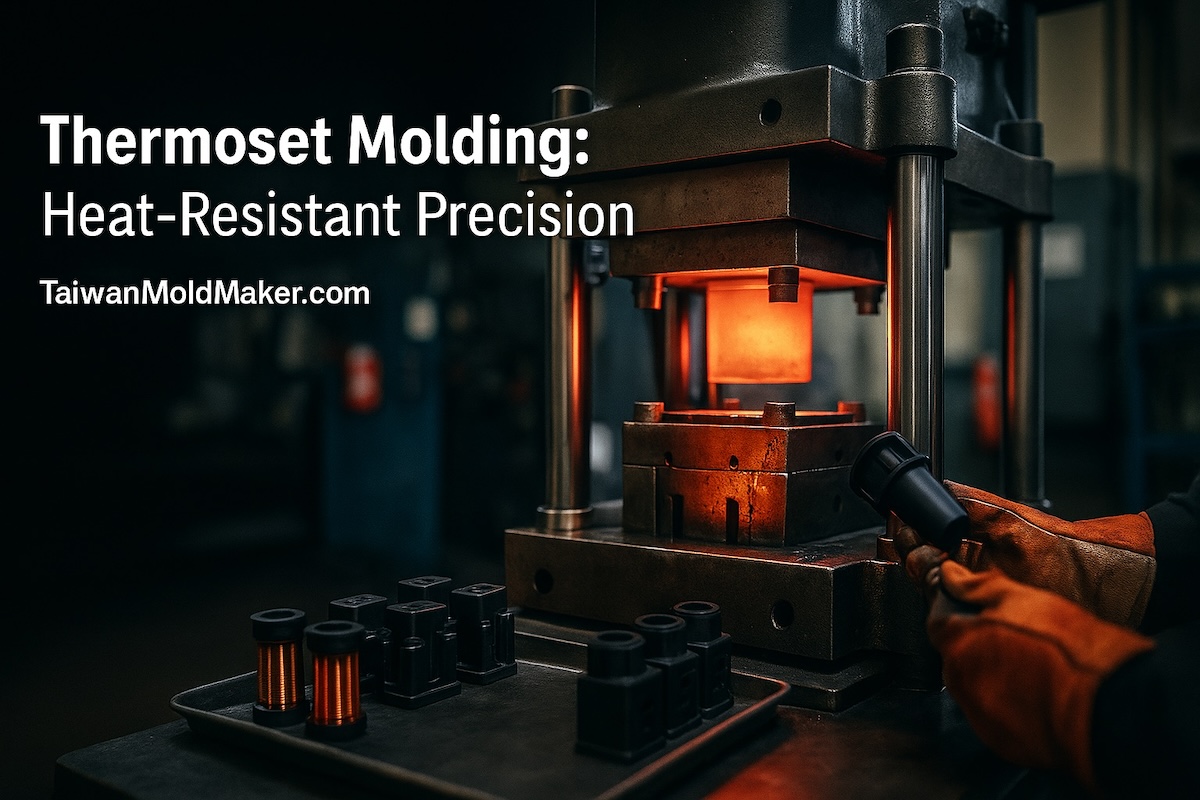Utilize Thermoset Molding for Heat-Resistant, Dimensionally Stable Plastic Parts
Utilize Thermoset Molding for Heat-Resistant, Dimensionally Stable Plastic Parts

Utilize Thermoset Molding for Heat-Resistant, Dimensionally Stable Plastic Parts
High heat • Electrical insulation • Low creep & shrinkage • Repeatable cosmetics
For parts that must hold tight dimensions at elevated temperatures, resist chemicals, and maintain electrical insulation, thermoset molding outperforms many engineering thermoplastics. Using compression, transfer, or thermoset injection, the TaiwanMoldMaker.com network engineers robust, audit-ready programs—from DFM and tooling to automated production and post-cure.
Explore related services:
Custom Mold & Design Maker -> Mold Service -> Injection Mold -> Molding -> Customer Examples -> Contact ->
Why Thermosets? (When to Choose Them)
-
Heat resistance & stability: cross-linked networks deliver high RTI/HDT and low CLTE, keeping tolerances at temperature.
-
Electrical properties: strong dielectric strength, arc/track resistance options for coils, switchgear, sockets.
-
Mechanical durability: low creep under load; good fatigue at elevated temperatures.
-
Chemical & solvent resistance: strong performance for cookware handles, pump components, appliance internals.
-
Dimensional repeatability: low shrink and post-cure control enable precise fits for inserts and threads.
Common Materials & Use Cases
-
Phenolic (PF/Bakelite; BMC/SMC/GM): high heat & electrical; coil bobbins, terminal blocks, cookware/hand tools.
-
Epoxy Molding Compounds (EMC): semiconductor encapsulation, high-precision electricals.
-
Melamine/Urea (MF/UF): decorative/food-contact tableware, appliance knobs (grade-dependent).
-
Unsaturated Polyester (UP) BMC/SMC: structural housings, automotive under-hoods, metered-dose device parts.
Need food-contact, V-0 flame rating, or glow-wire? We’ll select compliant grades during RFQ.
Process Options (Pick What Fits Your Part)
-
Compression molding: pre-measured charge (BMC/SMC) placed in a hot mold; excellent surface and fiber wet-out; great for larger sections.
-
Transfer molding: controlled flow from a transfer pot into heated cavities; good for insert-rich parts and tight flash control.
-
Thermoset injection molding (TSIM): cooled barrel prevents premature cure; hot mold cures quickly—ideal for medium-sized, higher-volume parts.
DFM & Tooling Guidelines (Thermoset-Specific)
-
Draft & radii: 1.0–2.0° typical; avoid sharp corners to reduce knit and stress-whitening.
-
Wall design: keep sections uniform; use BMC flow leaders and radii to avoid voids.
-
Venting & flash control: micro-vents at flow ends; matched parting lines with hardened, corrosion-resistant steels.
-
Inserts: pre-heat metal inserts; design undercuts/knurls for pull-out strength; account for differential expansion.
-
Tool steels & coatings: phenolics are abrasive/corrosive—spec H13/S136, chrome or nitriding where needed.
-
Post-cure: define oven profile to finish cross-linking and stabilize dimensions.
Get a 48-Hour DFM Pack with gating/charge plan, cure model, and risk register:
Custom Mold & Design Maker ->
Process Control & Quality (Audit-Ready)
-
Cure control: mold-temp mapping, on-tool thermocouples, and time/temperature/pressure recipes.
-
Metrology: FAIR + CMM/scan; thread gauges; torque/creep/arc-resistance as required.
-
Vision SPC: flash, short, burn, and knit-line detection; logo/readability checks.
-
Capability: CpK ≥ 1.67 at CTQs at launch; ≥2.00 steady.
-
Traceability: MES dashboards for OEE, CpK, scrap, energy kWh/kg, lot genealogy.
See similar controls in practice: Molding ->
Typical Advantages vs. High-Temp Thermoplastics
| Requirement | High-temp TP (e.g., PEEK/PAI) | Thermoset |
|---|---|---|
| Dimensional stability @ heat | Good | Excellent (cross-linked; low creep) |
| Tooling/processing complexity | Medium-High | Medium (venting & cure focus) |
| Cost for mass electricals/handles | High | Competitive |
| Recyclability | Re-meltable | Not re-meltable (design for longevity/ESG via PCR inserts/metal swap) |
Automation & Secondary Ops
-
Robot take-out & insert loading (pre-heat nests).
-
In-cell finishing: deflash/trim, pad/ink print, laser mark.
-
Assembly & test: leak/torque/hi-pot as needed.
Integration playbook & PM standards: Mold Service -> • Components: Injection Mold ->
Timeline Snapshot (Representative)
Week 0–1: 48-Hour DFM & cure strategy -> approve.
Week 2–4: Tool build (vents, corrosion-resistant steel, heated platens).
Week 4–5: T0/T1 with post-cure; DOE to lock golden recipe.
Week 6+: Pilot -> vision/SPC -> scale & documentation.
RFQ Template (Copy/Paste)
Subject: RFQ – Thermoset Molding (Heat-Resistant, Dimensionally Stable Parts)
Attachments: STEP/IGES + 2D with CTQs & cosmetic map
-
Annual volume & first PO quantity; target launch date
-
Material target: PF/EMC/MF/UF/UP (BMC/SMC) and regulatory needs (UL, GWIT/GWFI, food-contact)
-
Inserts (qty/type/finish/pre-heat requirements)
-
Cosmetic spec (texture/polish), flash limits, parting line locations
-
Process preference (compression / transfer / TSIM)
-
Validation scope (FAIR, CMM/scan, CpK @ CTQs, arc/track, torque/creep)
-
Automation & finishing (deflash, print/laser, weld/assembly)
-
Data & traceability (MES, energy kWh/kg, genealogy)
-
Packaging & logistics (rust control, pallet map; Incoterms; milestones T0/T1/buy-off/SOP)
We’ll return a 48-Hour DFM + Cost Pack with cure model, cycle estimate, and tooling roadmap.
Contact ->
Why TaiwanMoldMaker.com
-
End-to-end ownership: DFM -> tooling -> automated thermoset molding -> post-cure -> assembly.
-
Right-sized processes: compression, transfer, and TSIM with venting & cure discipline.
-
Proven quality system: scientific recipes, vision SPC, and MES dashboards for OEE/CpK/scrap/kWh/kg.
Explore more:
Customer Examples -> Molding ->








